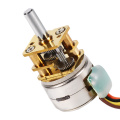15BYJ25 - 004 Micro Stepper Motor
Basic Info
Model No.: 15BYJ25-004
Product Description
Gear reduction motor is a component of a gear reducer and a motor. This type of component is also commonly referred to as a gearbox motor or a geared motor. It is usually assembled and assembled by a professional reducer manufacturer.
Gear reduction motors are widely used in automatic mechanical equipment, especially in packaging machinery, printing machinery, corrugated machinery, color box machinery, conveying machinery, food machinery, three-dimensional parking equipment, automatic storage, three-dimensional warehouse, chemical, textile, dyeing and finishing equipment, etc. Micro gear reduction motors are also widely used in the fields of electronic locks, optical equipment, precision instruments and financial equipment.
15BYJ25-004 Reduction Stepper Motor Parameters
| MODEL | ITEMS | SPEC |
| 15BYJ25-004 | Rated Voltage | 5V DC |
Phase | 2 | |
Reduction Ratio | 1/52 | |
Steo Angle | 0.35° | |
Exciting Method | 2-2 | |
Direct-current Resistance | 50Ω±10% | |
No-load pull-in Frequency | ≥800Hz | |
No-load pull-out Frequency | ≥1000Hz | |
pull-in Torque | ≥80mN.m | |
Insulation Class | F |
Drawing of 15BYJ25-004 Reduction Stepper Motor

Applications of Stepper Motor
• 3D printing equipment
• Barrier gate
• Printing presses
• Automatic toilet seat cover
• Electric tailgate
• Nano sprayer
• Vending machines
• Aircraft – In the aircraft industry, stepper motors are used in aircraft instrumentations, antenna and sensing applications, and equipment scanning
• Automotive – The automotive industry implements stepper motors for applications concerning cruise control, sensing devices, and cameras. The military also utilizes stepper motors in their application of positioning antennas
• Chemical – The chemical industry makes use of stepper motors for mixing and sampling of materials. They also utilize stepper motor controllers with single and multi-axis stepper motors for equipment testing
• Consumer Electronics and Office Equipment – In the consumer electronics industry, stepper motors are widely used in digital cameras for focus and zoom functionality features. In office equipment, stepper motors are implemented in PC-based scanning equipment, data storage drives, optical disk drive driving mechanisms, printers, and scanners
• Gaming – In the gaming industry, stepper motors are widely used in applications like slot and lottery machines, wheel spinners, and even card shufflers
• Industrial – In the industrial industry, stepper motors are used in automotive gauges, machine tooling with single and multi-axis stepper motor controllers, and retrofit kits which make use of stepper motor controllers as well. Stepper motors can also be found in CNC machine control
• Medical – In the medical industry, stepper motors are utilized in medical scanners, microscopic or nanoscopic motion control of automated devices, dispensing pumps, and chromatograph auto-injectors. Stepper motors are also found inside digital dental photography (X-RAY), fluid pumps, respirators, and blood analysis machinery, centrifuge
• Scientific Instruments –Scientific equipment implement stepper motors in the positioning of an observatory telescope, spectrographs, and centrifuge
• Surveillance Systems – Stepper motors are used in camera surveillance
Analysis of the reasons for the inaccurate positioning of the stepper motor
Forcing the motor to start directly at the required speed (greater than the limit starting rate), "lost steps" or no response may occur. When the motor runs to the end, although it has immediately stopped sending pulses to stop it, but due to inertia Effect, the phenomenon of crossing the end point will occur, that is, overshoot will occur.
The main reasons for the overshoot caused by inertia and the inaccurate positioning of the stepper motor are as follows:
(1) The controller of the control system has malfunctioned;
(2) The software has design defects;
(3) The stepper motor may suffer from interference during the working process, resulting in inaccurate motor positioning;
(4) The initial speed of the stepper motor is required to be too high, which far exceeds the limit starting frequency of the stepper motor, or the acceleration is too large, resulting in "lost steps";
(5) Loss of pulses during commutation, accurate positioning in one-way operation, deviation in positioning after commutation, and the greater the deviation value as the number of commutation increases;
(6) The power of the stepper motor cannot meet the requirements of the system.
Since the open-loop control system has the advantages of convenient operation and low price, the basic reactive stepping motor used in our country is the open-loop control. Although the stepper motor is widely used, it cannot be used under normal conditions like an ordinary AC (direct) current motor, and the operating speed from the starting point to the end point is theoretically, when the limit starting frequency of the motor is greater than the operating speed , The motor can run as required and reach the expected operating speed. When running to the end of the stroke, it can also immediately send out a pulse that can realize the stop function and stop the motor. But the actual situation is that the limit starting rate that the stepper motor can achieve is low, which is far from meeting the requirements of higher operating speed. Under such working conditions, if the motor is forced to start directly at the required speed (greater than the limit start rate), "lost steps" or no response will occur. When the motor runs to the end point, although it has stopped sending pulses immediately to make it stop, due to inertia, it will cross the end point, that is, overshoot.
The issue that requires our special attention is that in order to ensure the positioning accuracy of the system and obtain a higher positioning speed, mainstream systems all divide the positioning process into two stages. They are: coarse positioning stage and fine positioning stage. According to production practice experience, "lost step" and "overshoot" are the two most common "culprits" that seriously affect the positioning accuracy of stepper motors during operation.
DC Motor stepping motor DC motor 齿轮减速机 深圳网站建设 深圳seo优化 仿真恐龙制作 净水器代理 自贡净水器批发 厦门净水器 珠海净水器代理 天津净水器代理 重庆净水器代理 沈阳净水器代理 杭州净水器代理 汕头净水器代理 苏州净水器代理 温州净水器代理 宁波净水器代理 昆山净水器代理
Contact us if you need more details on 15BYJ25. We are ready to answer your questions on packaging, logistics, certification or any other aspects about 15BYJ25 Stepper Motor、15BYJ25 Micro Stepper Motor. If these products fail to match your need, please contact us and we would like to provide relevant information.Product Categories : Other Products > Micro Stepper Motor








